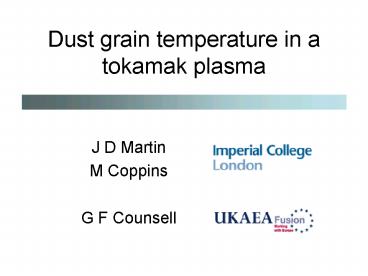Dust grain temperature in a tokamak plasma - PowerPoint PPT Presentation
1 / 14
Title:
Dust grain temperature in a tokamak plasma
Description:
Modelling the transport of impurities in dust. Hydrocarbons, tungsten, CFC. Safety issues tritium ... Interested in edge region. Scrape-off layer (SOL) ... – PowerPoint PPT presentation
Number of Views:83
Avg rating:3.0/5.0
Title: Dust grain temperature in a tokamak plasma
1
Dust grain temperature in a tokamak plasma
- J D Martin
- M Coppins
- G F Counsell
2
Dusty Plasmas
- Individual Grains Collective phenomena
Morfill et al (1997)
Garscadden et al (1994)
3
Importance of Dust in Tokamaks
- Modelling the transport of impurities in dust
- Hydrocarbons, tungsten, CFC
- Safety issues tritium retention, explosive
limit, cracking of water - Understanding dust will lead to more efficient
discharges
Winter (1998)
4
Outline
- Tokamak plasmas
- Plasma-surface interaction
- Dust grain charge
- Dust grain temperature
- Conclusions
5
Tokamak Plasmas
- Interested in edge region
- Scrape-off layer (SOL)
http//www.physics.auburn.edu/plasma/fusion/fusio
n_lab/fusion.html
6
Plasma-Surface Interaction
- Electrons react quickest colliding with the wall
to produce a negative potential - Ions accelerated towards wall causing a shock
(presheath) - Thin positive space charge region (sheath) with
large potential drop - Reach steady state with recycling of particles
7
Dust Creation Mechanisms
- Sputtering
- Energy supplied by ions breaks bonds in the solid
- Arcing
- Driven by sheath potential
- Evaporation
- Agglomeration
- Flaking
MAST dust production
8
Dust Grain Charging
- Dust generally ve
- Electrons Maxwellian
- Ions in attractive potential
- Use probe theory
- Find floating potential by equating currents
- Take into account secondary emission
9
Heating Cooling Mechanisms
- Ion, electron and neutral bombardment
- Ion-electron recombination and molecule formation
- Backscattering
- Secondary electron emission
- Radiative cooling
10
Steady-State Temp Carbon
- Independent of dust grain size
11
Tungsten Complication
- For tungsten, the secondary emission yield can
exceed 1 - Electron flux is -ve
- Dust grain charge flips sign
- Dust charges ve until secondaries are trapped
- Potential well found in kinetic simulations by G.
Lapenta
12
New Charging Heating
- Modal energy of secondaries around 3eV
- Ions are Maxwellian
- Electron flux balances ion flux, without
secondary contribution - Little energy lost to secondaries
13
Steady-State Temp Tungsten
14
Conclusions
- Dust grains can survive at high temperatures in
tokamaks - Tungsten is interesting
- What next?
- Sort out a better model for the positive charging
process - Use current model with tokamak plasma conditions
simulated by code































